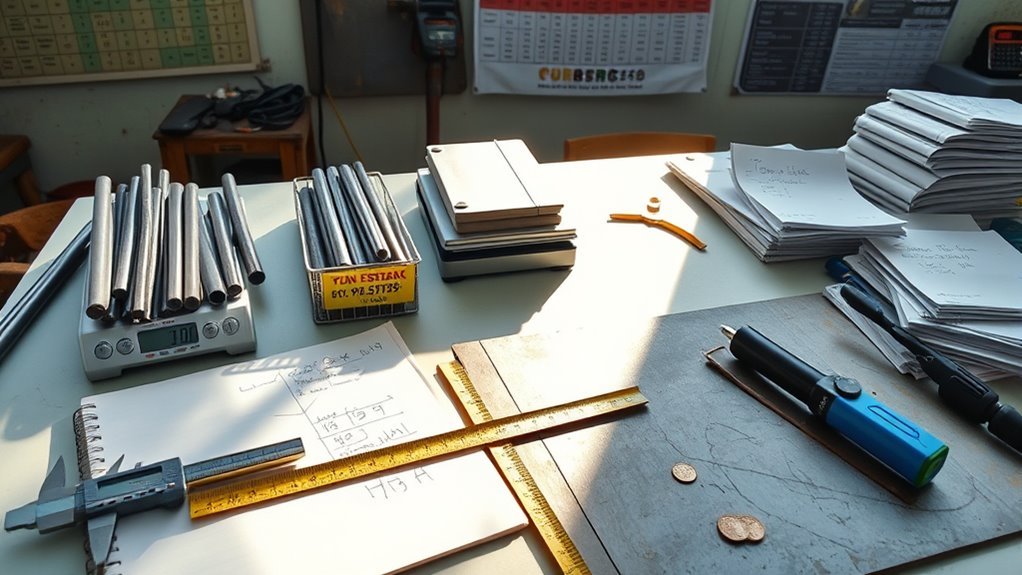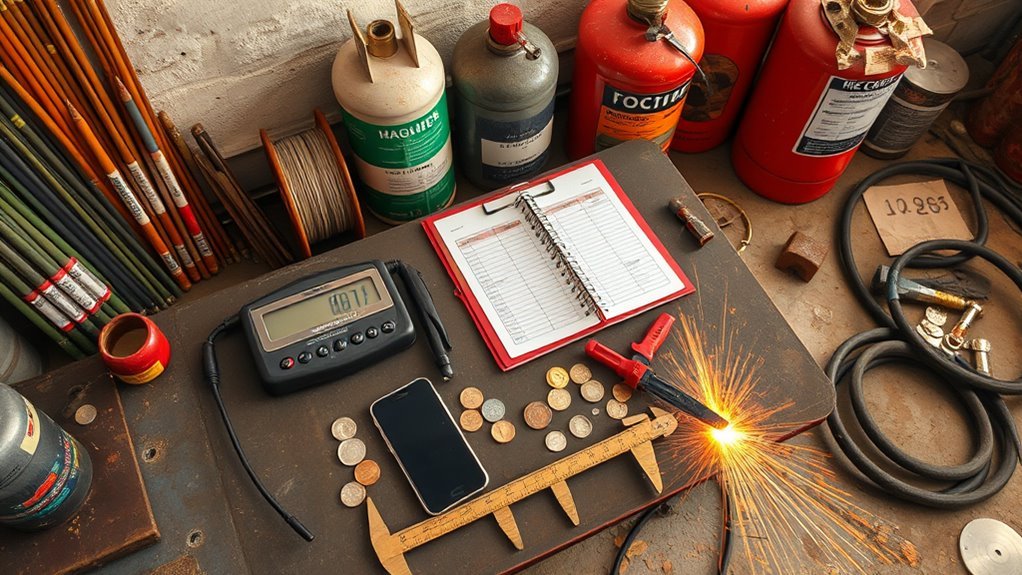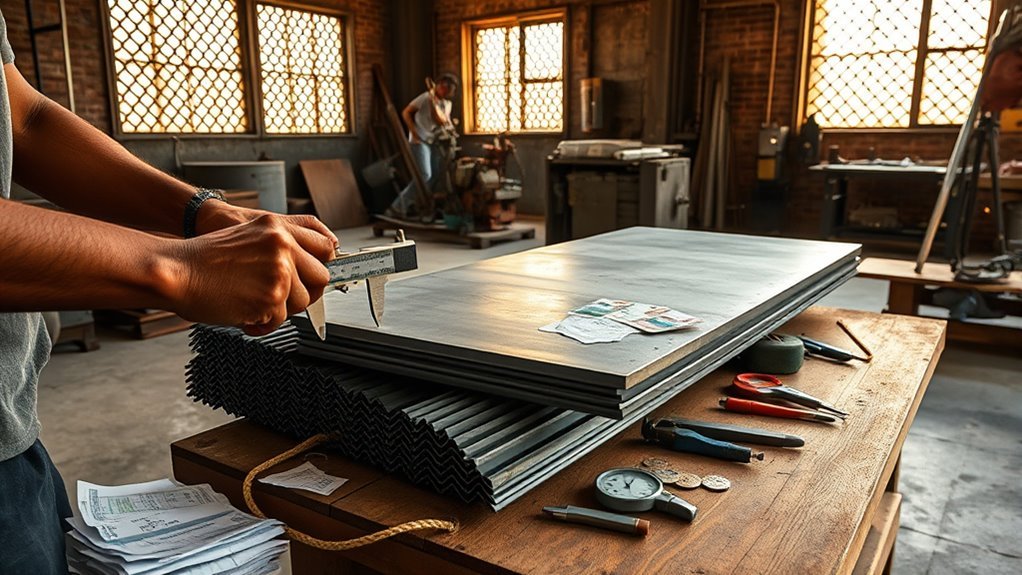To calculate welding cost in India, break the job into material, consumables, labor, machine ops, finishing, logistics, overheads and margin. Start with raw material weight × rate plus 5–10% scrap, add filler/electrode and shielding-gas use with loss factors, then compute welder hours using duty-cycle productive time × hourly rate. Include cutting/bending rates, surface treatment and inspection fees, transport and packing, add 5–15% contingency and your profit—follow the steps below for full detail.
Understanding the Key Components of Welding Cost

When you calculate welding cost, break the job into clear components so you can price each element precisely:
- material cost (weight × rate plus 5–10% scrap),
- processing (cutting, bending, welding charged per operation or hour),
- labor (man-hours × hourly rate),
- finishing (coating or galvanizing charged per area or kg),
- and logistics (transport, packaging, loading).
You’ll list cost factors for each:
- raw material weight × per‑kg rate plus scrap allowance,
- processing priced by operation or minute (laser cutting ₹10–₹50/min, MIG welding ₹200–₹500/hr),
- and labor as man‑hours × rate (₹150–₹400/hr general, up to ₹700/hr skilled).
Include finishing (powder coat ₹15–₹50/ft², galvanize ₹20–₹50/kg) and transport or handling fees.
Match welding techniques to processing rates when estimating.
Calculating Raw Material and Scrap Allowance

Because accurate material budgeting starts with measured inputs, calculate raw material cost by multiplying the actual or estimated weight (kg) by the rate (₹/kg), then add a scrap allowance of 5–10% to that weight before pricing to cover wastage. You’ll apply surcharges for special grades and document each material type and rate. Track actual versus estimated weight to refine raw material costs and improve future estimates. Maintain disciplined scrap management to avoid budget overruns.
| Item | Action |
|---|---|
| Weight (kg) | Measure or estimate |
| Rate (₹/kg) | Apply supplier price |
| Scrap allowance | Add 5–10% to weight |
| Record keeping | Log actual vs estimated |
Follow this methodical process to keep raw material costs verifiable and controlled.
Estimating Welding Consumables and Shielding Gas Expenses

To estimate consumable and shielding gas costs accurately, start by listing each filler metal or electrode (type and diameter), its unit price and manufacturer loss rate.
Then multiply the estimated weld metal weight by the loss factor to get required quantity and cost; for processes like submerged arc welding include flux at roughly 1 kg flux per 1 kg deposited weld metal.
You’ll then calculate shielding gas use from flow rate and welding hours, knowing a 200 bar cylinder (~10,000 L) at 12–15 L/min supports about 10–12 hours.
Maintain strict consumable management and monitor welding efficiency to reduce waste.
- Record electrode/filler specs, unit cost, loss factor
- Compute required kg and cost per consumable
- Estimate gas volume from flow × time
- Divide total gas by cylinder capacity for cylinder count
Labor Cost: Welder Rates, Duty Cycle and Productivity

Start by quantifying the hourly labor rate you’ll apply—typical Indian welder rates span roughly ₹150–₹400/hr for general workers and ₹500–₹700/hr for highly skilled or union welders—then adjust that base by the effective productive time determined from duty cycle and downtime.
Calculate effective hourly output by multiplying nominal duty cycle (percentage of operation before cool-down) by clock hours; for example, a 60% duty cycle on an 8‑hour shift yields 4.8 productive hours.
Multiply the duty cycle by shift hours to find productive welding time — e.g., 60% of 8 hours = 4.8 hours.
Subtract average lost time for tacking, cleaning, electrode changes and breaks to get net productive hours.
Divide required weld hours by net productive hours per welder to determine headcount and total labor hours.
Monitor welding efficiency and reduce downtime for clear cost optimization.
Machine Operations: Cutting, Bending, and Welding Machine Costs

Now you’ll quantify machine operations by breaking costs into cutting, bending and welding components.
Use cutting machine rates (₹10–₹50/min) and expected bending operation time with per-bend costs (₹5–₹20) to compute per-piece cut-and-form cost.
Then factor welding machine duty-cycle and hourly rates (MIG ₹300–₹700, TIG ₹400–₹1000) to convert welding time into an accurate machine-cost contribution.
Cutting Machine Rates
One clear way to control fabrication expenses is to break machine-operation costs into per-minute and per-action charges so you can add cutting, bending, welding, and finishing into a single estimate.
For cutting, focus on laser cutting rates and machine efficiency: typical laser cutting in India runs ₹10–₹50 per minute depending on material thickness and type. Include setup and minor finishing time when calculating effective per-part cost.
- Estimate active cut minutes per part and multiply by the per-minute rate.
- Add fixed setup time distributed across batch quantity.
- Factor machine efficiency (idle time, nesting quality) into yield calculations.
- Add separate grinding/polishing charges (₹15–₹50) if final finish is required.
Document assumptions clearly so you can repeat and compare quotes.
Bending Operation Time
Bending time drives part cost, so you should measure and record per-bend durations for each material and thickness rather than relying on a flat rate.
Track setup, adjustments and cycle time separately: setups often add significant minutes, especially when switching bending techniques or bending materials.
Use measured times to apply India’s typical CNC bend cost range (₹5–₹20 per bend) as a verification, not a substitute.
Account for machine efficiency — faster machines shorten cycle time and lower per-bend cost; slow machines need added labor hours.
Record common thickness/material combos, tool changes, and batch sizes so you can amortize setup time properly.
Precise timing lets you calculate labor, machine-hour charges, and total bending cost accurately for each job.
Welding Machine Duty-cycle
Having recorded per-bend times and setup impacts, you should next factor machine duty cycles into your cost model because they determine how long cutting, bending, and welding equipment can run before required cooling breaks.
The duty cycle tells you percentage runtime per 10 minutes; a 60% duty cycle means 6 minutes on, 4 minutes off. Use duty cycles to calculate effective production rates, labor hours, and incremental cost from idle cooling.
Consider variations: cutting (50–80%), bending (30–50%), and welding machines whose duty influences welding efficiency and throughput. Include machine maintenance in overheads since higher duty demands more frequent servicing to preserve performance.
Translate cycles into cycle-time multipliers to estimate real hours and cost per weld or bend.
- Record nominal duty cycle
- Convert to usable minutes per shift
- Adjust for cooling downtime
- Add maintenance allowance
Finishing, Surface Treatment and Inspection Charges
You’ll start by listing required surface-preparation methods (degreasing, sanding, blasting) and their unit costs so you can allocate time and consumables accurately.
Then itemize coating and plating rates—powder coating (₹15–₹40/ft²), galvanizing (₹20–₹50/kg), anodizing (₹10–₹30/ft²) and grinding/polishing (₹15–₹50/piece)—to calculate per-piece finishing cost.
Finally, include inspection and testing fees as a separate line item to guarantee compliance and to capture the final quality-control expense.
Surface Preparation Methods
Although surface preparation may seem like a secondary step, it directly affects both the cost and longevity of a welded part, so you should plan for finishing, surface treatments, and inspections from the start.
You’ll factor grinding or sanding (₹15–₹50 per piece) into budgets to achieve required surface cleanliness for reliable welding techniques and consistent weld quality. Finishing and treatment choices alter per-unit and per-area costs, and inspections confirm compliance.
- Mechanical prep: grinding/sanding — cost varies with complexity.
- Finishing: powder coating ₹15–₹40/ft² for durability and corrosion resistance.
- Treatment: galvanizing adds ₹20–₹50/kg for protection and lifespan extension.
- Inspection: variable charges guarantee quality control and reduce rework.
Plan these items to minimize repairs and improve welding efficiency.
Coating and Plating Rates
When you factor coating and plating into welding costs, calculate both per-unit and per-area charges—powder coating typically runs ₹15–₹40/ft², anodizing for aluminum ₹10–₹30/ft², and galvanizing about ₹20–₹50/kg—plus any inspection fees that may be flat or complexity-based; these figures directly change material, labor, and overhead estimates and should be applied early in project budgets to avoid surprises.
You’ll list required coating types and plating processes per component, measure area or weight, and multiply by supplier rates.
Add handling, masking and cure-time labor to labor hours. Factor minimum batch charges, transport and rework contingency (typically 5–10%).
Document unit rates and assumptions clearly so bids remain auditable and revisions traceable during execution.
Inspection and Testing Fees
Because inspection and testing directly govern weld acceptability and downstream costs, you should budget these fees up front and itemize them by type (visual, NDT, third‑party certification) and frequency.
Inspection methods vary: visual checks cost ₹1,000–₹10,000 per visit, while NDT (ultrasonic, radiographic) runs ₹2,500–₹15,000 depending on scope. Surface treatment adds ₹15–₹50/ft² for powder coating or ₹20–₹50/kg for galvanizing.
Testing standards and regular inspections can cut rework and long‑term expense; expect inspection/testing to form roughly 10%–15% of total welding costs.
- Itemize each inspection by method, frequency, and unit rate.
- Allocate NDT selectively for critical welds only.
- Include third‑party certification where required.
- Track inspection outcomes to refine future budgets.
Logistics, Packaging and Onsite Service Costs
If you want to get an accurate welding project estimate, you must include logistics, packaging, and onsite service costs up front; these line items directly affect both price and schedule. You’ll assess logistics challenges and packaging solutions: transport often charges flat or ₹/km rates, loading/unloading fees apply, and packaging protects materials to avoid damage-related delays. Onsite service labor runs roughly ₹150–₹700/hr by skill and complexity. Calculate transport by distance and weight, add loading fees, and size packaging costs to material fragility. Efficient routing and proper crating lower risk and cost. Use the table below to break out core elements for each delivery.
| Item | Typical Basis |
|---|---|
| Transport | ₹/km or flat rate |
| Onsite labor | ₹150–₹700/hr |
Overheads, Contingencies and Profit Margin
Logistics, packaging and onsite service figures feed directly into your overhead-accounting, so you should now allocate fixed and indirect costs before setting contingencies and profit.
You’ll perform overhead allocation by summing workshop rent, utilities, maintenance, and admin, then apportioning to jobs on an hourly or activity basis.
Use contingency planning to cover 5%–15% of total costs for scope changes or surprises.
Include a contingency of 5%–15% of total costs to cover scope changes and unexpected issues.
Set profit after overheads and contingencies, targeting 10%–20% based on market and complexity.
Maintain disciplined accounting to validate assumptions and adjust rates.
- List all fixed and indirect overheads precisely.
- Choose a fair allocation base (hours, machine time).
- Apply contingency percentage transparently.
- Set profit margin aligned with local market trends.
Frequently Asked Questions
How Do Local GST Slabs Affect Final Welding Invoice Amounts?
Local GST slabs change final welding invoices by altering GST implications and taxable base; you’ll apply local tax rates to service and material portions, adjust for exemptions or composition schemes, and itemize GST collected and input credits accordingly.
Can Warranty or Post-Installation Support Be Costed Separately?
Like a separate invoice line, you can cost warranty terms and support options separately; you’ll itemize coverage, duration, response times, exclusions, and hourly or subscription rates, then add clear billing, renewal, and audit provisions for transparency.
How to Price Emergency or Out-Of-Hours Welding Services?
You price emergency or out-of-hours welding by applying emergency pricing strategies: set premium hourly rates, minimum call-out fees, and surge multipliers for out of hours demand, clearly itemize travel, parts, and rapid-response premiums in quotes.
Do Municipality Permits or Site Permits Add Extra Charges?
Like a tide adding layers, yes — you’ll incur extra charges because municipality regulations and permit fees apply; you’ll methodically itemize those costs, verify fee schedules, factor processing times, and document approvals to avoid surprises.
Are Foreign-Sourced Consumables Taxed Differently in India?
Yes, you’ll often face different taxation: import duties and local GST can apply based on import regulations, commodity classification, and declared value, so you’ll calculate duty plus applicable taxes, compliance fees, and any exemptions methodically.
Conclusion
To calculate welding cost in India precisely, sum material, consumables, gas, labor (productivity-adjusted), machine ops, finishing, logistics, overheads, contingencies and desired margin. For example: a fabricator welding a 500 kg mild-steel frame adds 5% scrap (25 kg), 10 kg electrodes, 40 minutes welder time at ₹400/hr, gas ₹500, machine depreciation ₹200, finishing ₹600, logistics ₹300 — then add 10% overhead and 12% profit to arrive at the final quote. Follow each step methodically and document assumptions.


